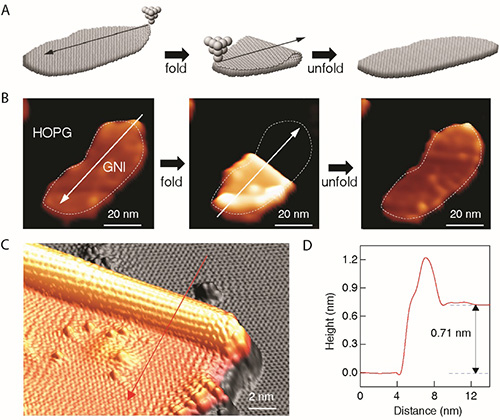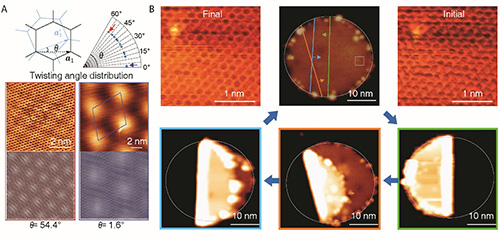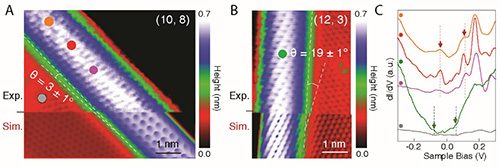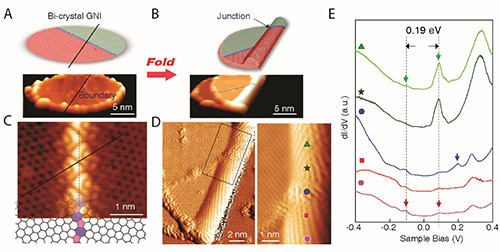

The discovery of fullerenes (Nobel Prize in Chemistry 1996), carbon nanotubes (CNT), and, more recently, the isolation of monolayer graphene (Nobel Prize in Physics, 2010) sparked a revolution in the fabrication of a variety of carbon allotropes. Graphene can be viewed as the building block of several allotropes, e.g., carbon nanotubes, three-dimensional (3D) graphene-based nanostructures (GNSs) and devices that have been either fabricated or predicted theoretically for potential applications, even machines.

Fig. 1 Construction of atomically well-defined folded GNSs by STM origami [Image: Institute of Physics]
Origami, the ancient art of paper folding, has been widely used in diverse areas, from architecture to battery design and DNA nanofabrication. It has also inspired the fabrication or simulation of macroscale origami graphene structures and devices. However, due to technical difficulties, atomically precise and controllable graphene origami for the creation of custom-design GNSs with quantum features has remained an open challenge.

Fig.2 Precisely controlled folding of a GNI along preselected directions [Image: Institute of Physics]
Recently, Professor Gao Hongjun 's group from the Institute of Physics of the Chinese Academy of Sciences demonstrated that origami is an efficient way to convert graphene nano-fragments into complex nanostructures with atomic-scale precision. By scanning-tunneling-microscope manipulation at low temperatures, they repeatedly folded and unfolded graphene nano-islands (GNIs) along an arbitrarily chosen direction. A bilayer graphene stack featuring a tunable twist angle and a tubular edge connection between the layers was formed. Folding single-crystal GNIs creates tubular edges with specified chirality, while folding bicrystal GNIs creates well-defined intramolecular junctions (IMJs). These tubular edges are structurally similar to carbon nanotubes (CNTs) and corresponding IMJs. Measurements of electronic properties combined with quantum calculations, based on atomic models of the structures, determine and explain these properties.

Fig.3 Tunable 1D tubular carbon structures with different chirality and electronic properties [Image: Institute of Physics]
The present paper reports the first experimental construction of the smallest-ever, atomically-precise origami graphene nanostructures together with property measurements and corresponding quantum calculations, establishing a platform for the construction of custom carbon nanostructures with engineered quantum properties and, ultimately, quantum machines. Furthermore, the results reported in this paper set the stage for the discovery of new and unusual phenomena, as the folded GNIs are composite structures comprising a CNT-like fold and a twisted bilayer graphene. For example, it may be worth exploring the superconductivity of the twisted bilayer graphene part with a magic twist angle attached to either a semiconducting or metallic tube or an IMJ.

Fig. 4 Creation of 1D carbon intramolecular junctions [Image: Institute of Physics]
Prof. Gao Hongjun and coworkers employed a scanning tunneling microscope tip to create atomically precise, custom-design, complex graphene origami nanostructures. This work provides a platform for constructing carbon nanostructures with engineered quantum properties and, ultimately, quantum machines.
This study, entitled “Atomically precise, custom-design origami graphene Nanostructures”, was published on Science.
The work was performed in collaboration with Professor Sokrates T. Pantelides from Vanderbilt University and Professor Min Ouyang from the University of Maryland in the United States.
For more information, please contact:
Prof. Gao Hongjun
Institute of Physics
Chinese Academy of Sciences
Email:hjgao@iphy.ac.cn
Source: Institute of Physics, CAS